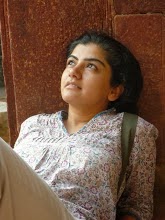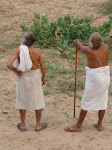I recently learned of a phrase used in the intellectual circles of America- Hindu Disneyland . I found this term so fascinating that like every other 'smart Alec' Indian, I am renaming it (for a more localized effect) Appu-Ghar Hinduism. There are many physical and physiological similarities between the two cults. It is common to see a Hindu bringing his maha-family of mother, father, widowed mother-in-law, visiting married sister with the 'jijaji', the kids, bhaiya, bhabi and the wife to a sacred Hindu site. As soon as the over-speeding, dust-covered Qualises (often with a neighbouring state's number plate) halt screechingly outside the pilgrimage center, the kids jump out and the men start looking for holes. The women complain about the long journey and their crushed sarees and pick up the water bottles that they most likely bought during the last trip.
During my recent trip to the Hindu holy site of Gupt-Godavari (litt. secret Godavari river), I had an opportunity to observe 'Appu-Ghar Hinduism' in action. In the late 1980s, to visit Appu-Ghar was not really the coolest thing to do, but we, the kids of upper-middle class parents, loved it. I loved the rides, ice-cream stands, and the Maggie counter; I loved shopping for some random thing I convinced my parents, I desperately needed, the inaudible announcements and the process of sticking with your parents in the crowds. The trip was more fun in a bigger group, it would give the kids a rare opportunity to wander around while mummy and aunties would share stories of their cruel mother-in-laws. The other hot topic was 'my kids'. I thought this exercise was an unsaid competetion of 'I suffered more' or 'I am a better mummy'. Nevertheless I loved Appu-Ghar.
The younger ladies walk together gossiping, sharing their shopping stories or casual neighbourhood stories that the listeners comment about. A common element is that these women are all dressed in their best 'outside home' clothes. They wear matching bangles, lipstick, bindis and Tulsi-inspired mid-hair vermillion that often shoots out like an arrow on their foreheads. The men walk talking about cell-phone or car models--Indian men genuinely refrain from talking about other kinds of models during family 'holy-site outings'. The group walks into the cave or temple together laughing and talking, unobservant of anything that surrounds them. At Gupt-Godavari they all enter a gufa, a cave under a barren surface from where the Godavari waters emerge-cool and clean. The group decides to play black-out with the family by calling out their names aloud. The names echo-they love it. A few others follow the trick. They also make indefinably blank eye-contact with the passerbys who have had their darshan. Smiling at strangers is such an un-Indian act but what is surely Indian is joining the passerbys in their loud 'hail God' calls. The group returns outside after darshan and resumes chatting about new topics.
Tuesday, April 22, 2008
Subscribe to:
Post Comments (Atom)


No comments:
Post a Comment